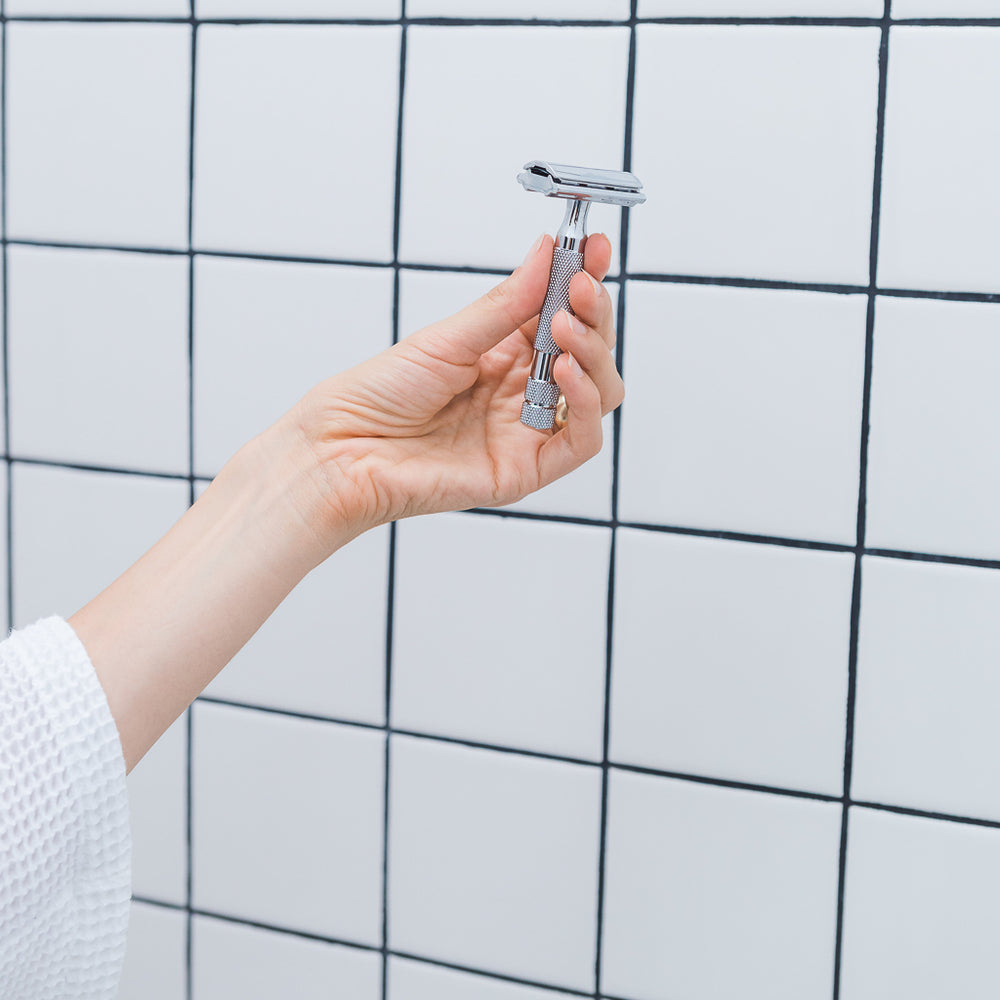Safety razors have been around since the turn of the century and have recently come back into popularity in the zero waste community. Made from long-lasting metal with a stainless steel blade, safety razors can last a lifetime with proper care and unlike disposable razors, they produce no plastic waste.
Learning to use a safety razor can seem intimidating at first—no one wants to painful cuts all over their body (ouch!). But with a little preparation and some practice, you will become a safety razor convert and love how they provide a close, smooth shave and help prevent ingrown hairs.
Here are a few tips to get you started:
1. How do I prep my skin?
Heat. You’ll want to soften your skin with hot water before you shave. The steam helps open your pores and makes it easier to shave, so it's a good idea to shave towards the end of your shower.
Exfoliate. It’s also a good idea to exfoliate your skin with a homemade coffee ground or sugar scrub. Dead skin cells can clog pores and cause ingrown hairs.
Lubricate. You’ll also need to lubricate skin before you start shaving. You don’t need to buy a special shaving cream, soap lather will do just fine.
2. How do I shave without cutting the sh#t out of myself?
You know those shaving commercials that show a woman dragging a razor up her entire leg in one smooth stroke? Forget that. Safety razors are different from the cartridge razors that we’re used to seeing on TV and require a different method to remove hair.
Short Strokes. Rather than dragging your razor in one continuous motion, which increases chances of nicking your skin, shave in short strokes (a few inches at a time), rinsing your razor in between.
Angle It. Unlike cartridge razors, safety razors don’t have a pivoting head. You will need to manually control the angle of your razor—try to aim for a 30-45 degree angle.
No Pressure. Try to apply very little pressure on your skin when your shaving. Safety razors have a weighted handle and are very sharp, so don’t need to apply additional pressure to get a close shave.
With the Grain. For sensitive areas, like the bikini line, pull your skin taut and shave with the grain (in the direction that the hair grows). This will provide a much milder shave, but may require a few extra passes to remove the hair completely.
3. What do I do with the used blades?
Unlike cartridge razors, you can recycle used safety razor blades. But before you toss your blades into the recycling bin, you will need to collect them in a ‘blade bank.’ A blade bank is a metal container used to collect used blades to help protect you and sanitary workers from getting cut. Check with your local municipality to make sure that they accept safety razor blades for recycling, or look for an approved sharps collection drop-off location such as a hospital or pharmacy.
4. Can I travel with a safety razor?
If you want to air travel with a safety razor you should plan to check your bag, otherwise it may be confiscated when you pass through security. Another option is to save your old cartridge razor for traveling purposes and leave your safety razor at home or skip the razor and go au naturale on your trip!
5. How do I care for and maintain my razor?
To prevent rust, you need to dry your safety razor after each use and store it in a dry place (aka not a steamy shower). Try to clean your razor at least once a month by taking it apart and scrubbing the pieces with an old toothbrush and castile soap. Be sure to dry thoroughly with a towel before you reassemble. If your razor still looks grimy, try soaking it in one part vinegar to four parts water for an hour or create a paste with baking soda and vinegar and scrub away.
I hope these tips have helped inspire you to try out a safety razor! It’s worth mentioning that in addition to providing a more eco friendly shave, safety razors are cheaper than cartridge and disposable razors over the long run. The razor itself can last a lifetime with proper care and the blades are very cheap to replace. What other benefits have you discovered from switching to a safety razor, or what questions do you have about getting started?

